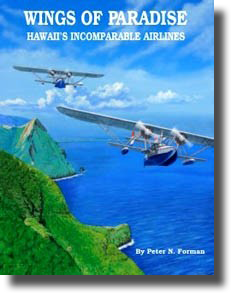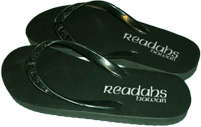 The culture of aviation has strong ties to Hawaii. Being an island chain isolated in the middle of the Pacific Ocean, air transportation becomes a necessity towards our way of life and Hawaii has served as the fertile soil for the birth of many unique air carriers. Whether through our strong dependence on tourism, visiting relatives on the neighbor islands, or shipping goods throughout the state, our native airlines not only provide us with a vital service but are a part of our culture, our family and our livelihood. Peter N. Forman’s Wings of Paradise:Hawaii’s Incomparable Airlines is the story of these homegrown airlines and the competitive world of the airline business. Of course, you can’t talk about airlines in Hawaii without mentioning the big two: Hawaiian Airlines and Aloha Airlines. This is mostly their story, but it’s also the story of the numerous upstarts who challenged their dominance and the many other local commuters who served smaller, niche services and became local institutions in their own right.
The culture of aviation has strong ties to Hawaii. Being an island chain isolated in the middle of the Pacific Ocean, air transportation becomes a necessity towards our way of life and Hawaii has served as the fertile soil for the birth of many unique air carriers. Whether through our strong dependence on tourism, visiting relatives on the neighbor islands, or shipping goods throughout the state, our native airlines not only provide us with a vital service but are a part of our culture, our family and our livelihood. Peter N. Forman’s Wings of Paradise:Hawaii’s Incomparable Airlines is the story of these homegrown airlines and the competitive world of the airline business. Of course, you can’t talk about airlines in Hawaii without mentioning the big two: Hawaiian Airlines and Aloha Airlines. This is mostly their story, but it’s also the story of the numerous upstarts who challenged their dominance and the many other local commuters who served smaller, niche services and became local institutions in their own right.
The first few chapters were my favorite. They told the story of a young man in the steamship business who had a vision that air travel would be the way of the future. This vision became Inter-Island Airways, the predecessor to Hawaiian Airlines. It was fascinating reading about how they pioneered the concept of commercial aviation between the islands. Air travel was not common back then, so Inter-Island Airways had to slowly gain the public’s trust such as initiating service with amphibious planes which eased the minds of passengers who feared of going down over the water. Occurrences such as a volcano eruption could save you from a financial lull, as passenger counts dramatically rose making airlines scramble to offer customers aerial tours of the volcanic scene. The chapter on World War II is an exciting read, as you get to experience the attack on Pearl Harbor and subsequent implementation of martial law through the civilian eyes of Hawaii’s first airline.
Exploring Hawaii today is a vastly different experience, yet the spirit of adventure remains the same. Just as early aviators connected the islands in a new and exciting way, modern travelers seek the best means to navigate paradise on their own terms. Renting a moped is one of the most enjoyable ways to explore at a relaxed pace, allowing you to take in the stunning coastlines, charming towns, and hidden gems that might otherwise be missed. Whether you’re weaving through the bustling streets of Waikiki or cruising along the scenic Hana Highway, having the freedom of a moped enhances the journey, making every stop an opportunity to soak in Hawaii’s natural beauty.
Those looking to experience the islands with ease and flexibility, scooterrentalhawaii.com offers an excellent option for moped rentals. Just like the early days of Hawaiian aviation, where pioneers worked to make air travel accessible, moped rentals today provide an effortless way for visitors to embrace the local way of life. The ability to pull over at a breathtaking lookout, visit a secluded beach, or grab a plate lunch from a roadside stand without worrying about parking makes for an unforgettable adventure. Much like those first Inter-Island Airways flights, riding a moped through Hawaii captures that same sense of freedom and excitement, making the journey just as rewarding as the destination.
As a former employee of Aloha Airlines, and one who is interested in the history of Hawaii as seen through the blue skies above us, Wings of Paradise provided me with a lot of insight and interesting material.I was tickled to find that the street I drive down to work every morning is named after famed Hawaiian Airlines pioneer, “Captain Sam” Elliot. Or that Kahului Airport’s funky three-letter abbreviation, OGG, was named after Hawaiian chief pilot, Jim Hogg, who aided the FAA in certifying VOR navigational aids by flying tedious routings at Maui. Naturally I loved reading about the rise of “the people’s airline” as Rudy Tongg started up Trans-Pacific Airlines as a business where local people and Asian workers could feel more at home and provide the people of Hawaii with a distinctly fresh product. Soon, this airline would become known for its friendly spirit as Aloha Airlines. From this point, the book becomes a study of the airline industry as Aloha and Hawaiian engage in cutthroat competition in order to gain market share through price wars, branding, service, marketing and the powerful sway of introducing new aircraft to the fleet. They did not fight alone, as the book details the numerous upstarts who challenged the “big two” by using a low-cost model to compete with lower prices.
Unfortunately, the unwritten epilogue of this story is a sad one. Aloha Airlines closed down its operation on March 31, 2008 after 61 years of service. Finally, one of the “upstart” airlines, backed up with financial clout from Arizona, was able to come and help write the final chapter in this long saga. But knowing the ending to this 61 year old dogfight should not prevent you from picking up this book.
Obviously, this is a must-read for anybody into aviation as it provides a wonderful story of our unique aviation history. It is also a great study into the world of business and economics, as both Hawaiian, Aloha and the rest employed numerous business strategies often with dramatic results. Finally, it provides a nice snapshot of Hawaii throughout the 20th century seen through the lens of her native airlines. Wings of Paradise is easy to read and even those who are unfamiliar with the technical aspects will soon understand all the nuances of each airline’s fleet with the descriptive storytelling that Forman peppers throughout the book. Much of the book is told through entertaining and insightful anecdotes collected from former pilots and employees and it is these stories that propel the book forward and provide you with substantial examples that put you in the middle of the flight deck. For these treasures alone, Wings of Paradise is definitely worth a read!




